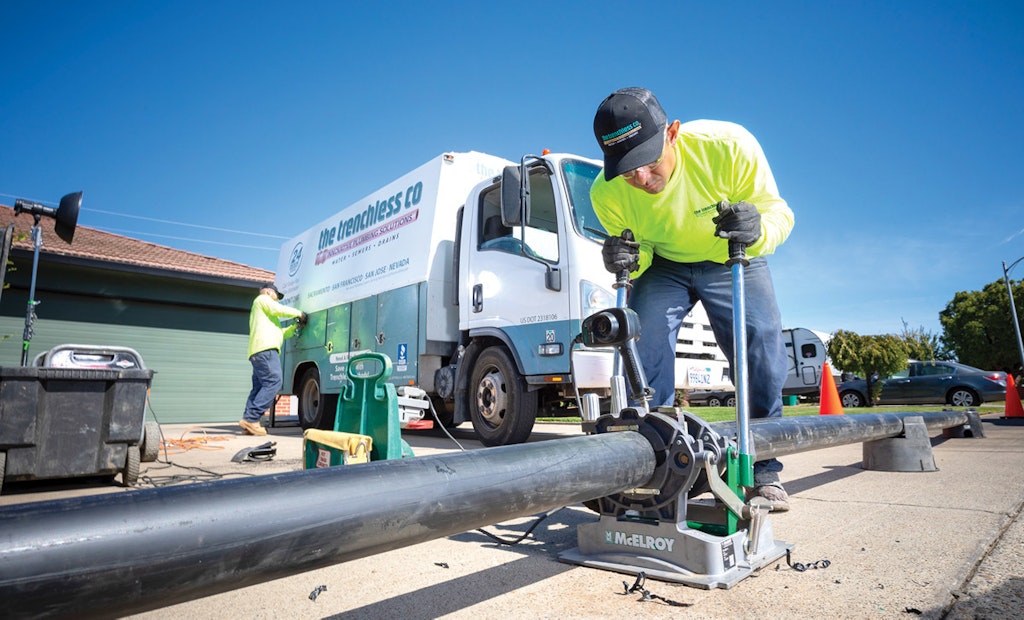
A safe pipe bursting job takes planning, knowledge and respect for the equipment. (Photo courtesy of The Trenchless Co.)
Interested in Safety?
Get Safety articles, news and videos right in your inbox! Sign up now.
Safety + Get AlertsProper training and thorough examination of the job site are the keys to a safe pipeline rehabilitation job.
Successful pipe bursting has been around for a while, and it’s safe to say Darrin Baker knows a thing or two about the subject. He has been in the trenchless industry for roughly 17 years and is currently the general manager for The Trenchless Co., which has been serving the greater Northern California area for 22 years.
Pipe bursting involves excavating a minimum of two pits to access each end of the pipe to be replaced. Once exposed, hydraulic equipment pulls a large bursting head through the existing pipe using a high-strength cable, breaking it apart from the inside while concurrently installing a new pipe behind the bursting head. The force it takes to pull the head and new pipe creates the biggest safety concerns for workers.
According to Baker, tackling a bursting job safely doesn’t have to be a complicated undertaking; it just takes planning, knowledge and respect for the equipment, and understanding what you’re getting into.
Plan ahead
“An inspection camera is the first tool to be used,” Baker says. “What we are looking for is differentiation in pipe materials, bends or anything that might change resistance, so we know what we’re getting into.”
If there are severe bends or too many elbows, more entry holes will be needed where bends are located to make sure the equipment can be used safely. The cable is then pulled through the open pits or equipment is set up in each one for a multiple phase job.
After an internal pipe inspection, The Trenchless Co. calls in an Underground Service Alert marking. In a commercial setting and in some residential cases, they may also do a private utility locate using their own sensors to locate potential conflicting underground utilities.
“After the locations of the utilities are marked, if needed, we expose them using hydrovac excavation,” Baker says. “Once exposed, we make sure they are far enough away from the burst. If they end up being less than 1 foot away from the burst, we will keep the utility exposed until the pipe is cleared so we can watch and ensure no damage is done.”
Understand equipment
Once the equipment is in the pit and it’s time to pull the cable, Baker says the biggest concern is overworking the tensile strength of the cable. “It can break, and if that happens the bursting equipment or broken cable can actually fly back in the hole,” he says. “It is under a lot of pressure. We burst with equipment up to 40 tons of pressure, but there’s equipment out there that can pull up to 200 tons.”
To avoid cable breakage, know the tensile strength of your cables and pay close attention to the psi gauges on equipment pulling the cable. “We simply don’t allow the machine to go past those strength ratings,” Baker says.
Routine inspections are also mandatory practice for Baker and The Trenchless Co. team. Cables are examined frequently and if there are any signs of fraying or damage they are taken out of use. “You can’t inspect your equipment enough,” Baker says. “Part of our annual budget is buying new cables. We anticipate replacing cables at least once a year or every other year depending on use.”
Take no chances
A surefire way to avoid a worker being struck by blowback equipment is removing them from the pit completely. Once the equipment is in place and set up, it’s protocol for Baker and his team to get out of that bursting hole. This wasn’t always possible, but technological advancements over time have allowed the transition.
“There have been subtle tweaks in the technology over time and many have been safety related,” Baker says. “There has been a lot put into place within our company and industrywide to really concentrate on staying away from the equipment when it’s operational. We use bands and locking teeth that go together to create the tension, so guys aren’t required to be in the hole.”
The cable is moved when the top teeth grip the cable on the upstroke and the bottom teeth engage and lock in on the cable on the downstroke of the hydraulic arm. The bands help to situate the teeth in the correct position. “Without the bands on the original bursting equipment, someone would have to physically push down the teeth to engage them during operation,” Baker says. “The bands take the human element out of it, so once the equipment is set up, the equipment does the work.”
In every construction situation, regardless of the circumstances, a smart move is ensuring every employee is prepared to avoid accidents and ready to react to them. “Our guys are all confined-space certified, CPR certified and trained in trench safety,” he says. “You never know who is going to be on site, so if you enable all your people to respond appropriately, you know whatever person is nearby an accident will be able to provide the right support.”





